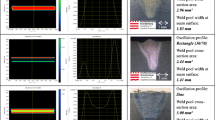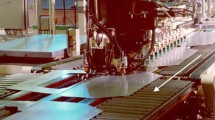Abstract
Remote laser welding which has benefits for both productivity and energy saving is receiving increased attention for automotive assembly lines. Introducing this innovative equipment requires a redesign process for assembly elements, for example to substitute resist spot welding with remote laser welding. The mating surfaces related to the welding need to be updated as well, but this is complicated when the shape design includes manufacturing and assembly elements based on current practice which hide the design intent. The challenge is to establish guidelines with the design parameters of automotive door frames and the process parameters of the joining process in order to maintain the design intent. In order to maintain the original design intent of the process planner, the author proposes a propagation model for the production stage which is defined as the interplay between parameters and quantitative comparison. The process parameters of remote laser welding are applied to the flange of the door frame. Also, the shape of each flange is synchronised with the changes according to the result of a quantitative comparison of the productivity and eco-efficiency. A design guideline tool to redesign the flanges was developed inside a commercial CAD system to show the proposed concept. Five flanges of a car door were subjected to redesign for introducing 4-kw remote laser welding with considerations of eco-efficiency, process time and weight change. The tools are shown to illustrate how to maintain design intent in the redesign process, and the concept was realised in a commercial CAD system.
Similar content being viewed by others
References
Kjellberg TA (1982) Integrerad Datorstöd för Mänsklig Problemlösning och Mänsklig Kommunikation inom Verkstadsteknisk Produktion begränsat till Produktutveckling, Produktionsberedning, Konstruktion och Tillverkningsberedning: En systemansats baserad på Produkt-modeller. KTH Royal Institute of Technology, Stockholm
Kjellberg TA, Stroud IA, Wingard LO (1983) GPM volume module in CAM-I perspective, CAM-I solid modelling conference held in Stockholm. Dept. of Manufacturing Systems, KTH, Sweden
Wilson P, Faux I, Ostrowski M, Pasquill K (1985) Interfaces for data transfer between solid modeling systems. IEEE Comput Graph Appl 5(1):41–51
CAM-I (1994) Application Interface Specification, Version 2.1 (AIS; 2 vols.). Technical Report R-94-PM-01. Consortium for Advanced Manufacturing International, Inc, Bedford
Anderson B, Ansaldi S (1998). ENGEN Data Model: a neutral model to capture design intent. PROLAMAT98, Kluwer.101 Philip Drive, Norwell, MA 02061, U.S.A.
Shih CH, Anderson B (1997, May). A design/constraint model to capture design intent. In Proceedings of the fourth ACM symposium on Solid modeling and applications (pp. 255-264). ACM, New York City
Middleditch AE, Reade CMP, Gomes AJ (1999) Set-combinations of the mixed-dimension cellular objects of the Djinn API. Comput Aided Des 31(11):683–694
Armstrong C, Bowyer A, Cameron S, Corney J, Jared G, Martin R, Middleditch A, Sabin M, Salmon J (2000) Djinn: specification and report. Information Geometers Ltd., Winchester
Stiteler, M. (2004). Construction History And ParametricS: improving affordability through intelligent CAD data exchange. CHAPS Program Final Report, Advanced Technology Institute, 5300. Advanced Technology Institute, 5300 International Boulevard, North Charleston, SC 29418, USA
ISO IS 10303-55:2005: Industrial automation systems and integration — Product data representation and exchange: Integrated generic resource: Procedural and hybrid representation. International Standard Organization, Geneva, Switzerland.
ISO 10303-108:2005: Industrial automation systems and integration—Product data representation and exchange: Integrated application resource: Parameterization and constraints for explicit geometric product models. International Standard Organization, Geneva, Switzerland.
ISO 10303-111:2007: Industrial automation systems and integration—Product data representation and exchange: Integrated application resource: Elements for the procedural modelling of solid shapes. International Standard Organization, Geneva, Switzerland.
Pratt MJ, Anderson BD (2001) A shape modelling applications programming interface for the STEP standard. Comput Aided Des 33(7):531–543
Mun D, Han S, Kim J, Oh Y (2003) A set of standard modeling commands for the history-based parametric approach. Comput Aided Des 35(13):1171–1179
Cheon SU, Kim BC, Mun D, Han S (2012) A procedural method to exchange editable 3D data from a free-hand 2D sketch modeling system into 3D mechanical CAD systems. Comput Aided Des 44(2):123–131
Kim J, Pratt MJ, Iyer RG, Sriram RD (2008) Standardized data exchange of CAD models with design intent. Comput Aided Des 40(7):760–777
Han S (2010) Macro-parametric: an approach for the history-based parametrics. Int J Prod Lifecycle Manage 4(4):321–325
Kim KY, Manley DG, Yang H (2006) Ontology-based assembly design and information sharing for collaborative product development. Comput Aided Des 38(12):1233–1250
Cheutet V, Léon JC, Catalano CE, Giannini F, Monti M, Falcidieno B (2008) Preserving car stylists’ design intent through an ontology. Int J Interact Des Manuf (IJIDeM) 2(1):9–16
Bidarra RAFAEL, Bronsvoort WF (2000) Semantic feature modelling. Comput Aided Des 32(3):201–225
Di Stefano P, Bianconi F, Di Angelo L (2004) An approach for feature semantics recognition in geometric models. Comput Aided Des 36(10):993–1009
Zou HL, Lee YT (2007) Constraint-based beautification and dimensioning of 3D polyhedral models reconstructed from 2D sketches. Comput Aided Des 39(11):1025–1036
Thompson WB, Owen JC, de St Germain HJ, Stark SR Jr, Henderson TC (1999) Feature-based reverse engineering of mechanical parts. IEEE Trans Robot Autom 15(1):57–66
Li M, Langbein FC, Martin RR (2010) Detecting design intent in approximate CAD models using symmetry. Comput Aided Des 42(3):183–201
Price MA, Robinson TT, Soban D, Murphy A, Armstrong CG, McConnell R, Roy R (2013) Maintaining design intent for aircraft manufacture. CIRP Annals-Manuf Technol 62(1):99–102
Ihwan S, Soonhung H (2013) Implementation of the direct integration from CAM to CAE for the PCB simulation. Comput Ind 64(8):1014–1021
Liu J, Liu X, Cheng Y, Ni Z (2015) A systematic method for the automatic update and propagation of the machining process models in the process modification. Int J Adv Manuf Technol 82(1):473–487, 1-15
Davison W (1840) New specimen of cast-metal ornaments and wood types
Alizon F, Shooter SB, Simpson TW (2009) Henry Ford and the Model T: lessons for product platforming and mass customization. Des Stud 30(5):588–605
Yang S, Zhao YF (2015) Additive manufacturing-enabled design theory and methodology: a critical review. Int J Adv Manuf Technol 80(1):327–342, 1-16
International Standard Organization. (2004). Industrial automation systems and integration—physical device control: data model for computerized numerical controllers: General process data (ISO 14649. 10-2004). Geneva, Switzerland
Li J, Chen Z, Yan X (2014) Automatic generation of in-process models based on feature working step and feature cutter volume. Int J Adv Manuf Technol 71(1-4):395–409
Shah, J. J., & Mäntylä, M. (1995). Parametric and feature-based CAD/CAM: concepts, techniques, and applications. John Wiley & Sons, Hoboken, New Jersey, United States
You CF, Chiu CC (1996) An automated assembly environment in feature-based design. Int J Adv Manuf 12(4):280–287
Ma YS, Britton GA, Tor SB, Jin LY (2007) Associative assembly design features: concept, implementation and application. Int J Adv Manuf Technol 32(5):434–444
Li GD, Zhou LS, An LL, Ji JF, Tan CB, Wang ZG (2010) A system for supporting rapid assembly modeling of mechanical products via components with typical assembly features. Int J Adv Manuf Technol 46(5):785–800
Guo Q, Tang H, Guo S, Li Y, Zhang J (2015) An automatic assembly CAD system of plastic profile calibrating die based on feature recognition. The International Journal of Advanced Manufacturing Technology, on-line published.
Han J, Pratt M, Regli WC (2000) Manufacturing feature recognition from solid models: a status report. IEEE Trans Robot Autom 16(6):782–796
Author information
Authors and Affiliations
Corresponding author
Rights and permissions
About this article
Cite this article
UM, J., Stroud, I.A. Design guidelines for remote laser welding in automotive assembly lines. Int J Adv Manuf Technol 89, 1039–1051 (2017). https://doi.org/10.1007/s00170-016-9096-0
Received:
Accepted:
Published:
Issue Date:
DOI: https://doi.org/10.1007/s00170-016-9096-0




